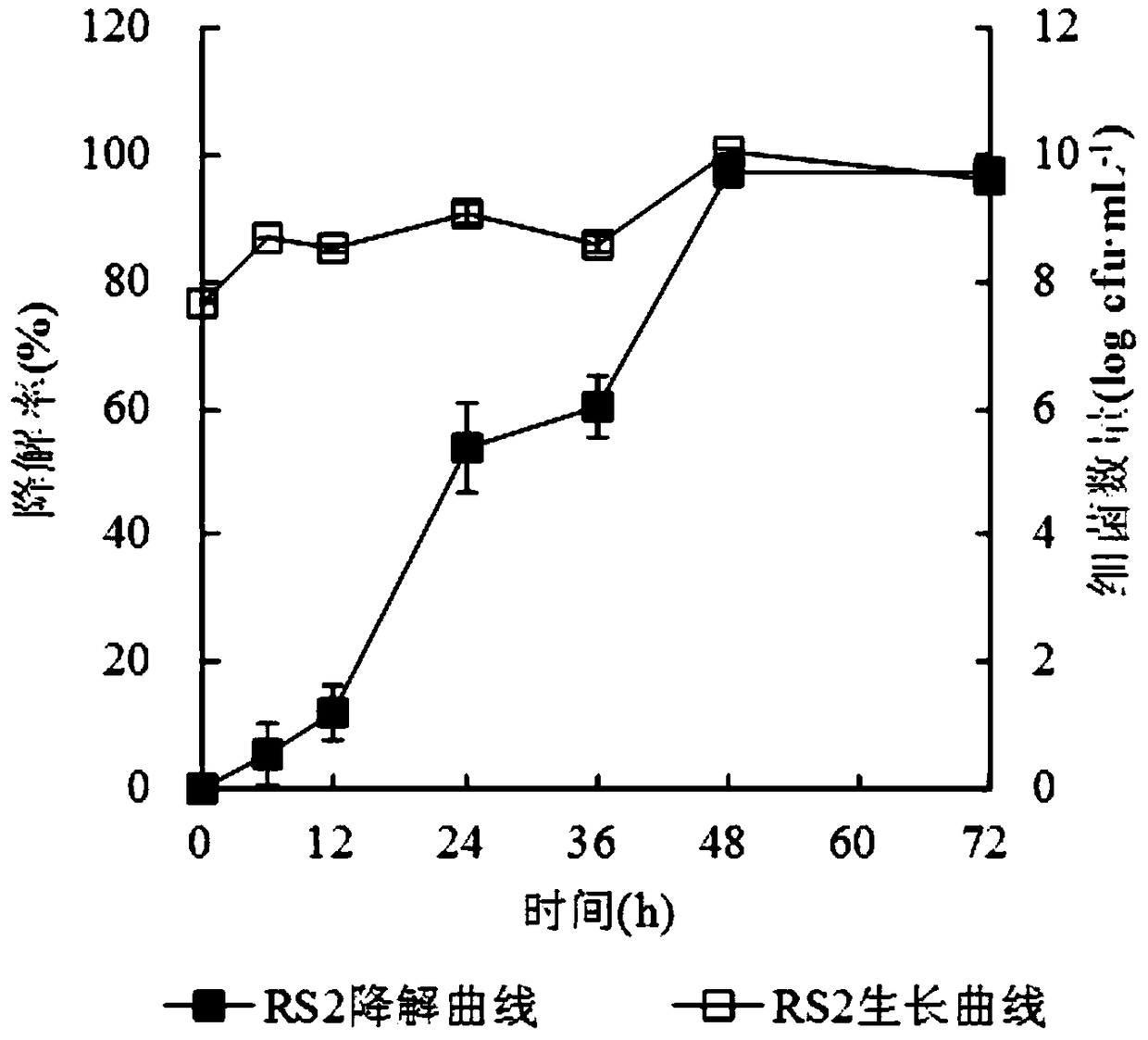A film-forming bacterium rs2 on the root surface with phenanthrene degradation function and its application
A technology for degrading bacteria and functions, applied in the recovery of bacteria and polluted soil, methods based on microorganisms, etc., can solve the problems of patent research and application that have not yet been reported, and achieve good removal effect, low production cost, and guaranteed safety. Effect
- Summary
- Abstract
- Description
- Claims
- Application Information
AI Technical Summary
Problems solved by technology
Method used
Image
Examples
Embodiment 1
[0031] The isolation and identification of embodiment 1 bacterial strain
[0032] Collect the main representative healthy plant samples (Pipetia chinensis, plantain, clamgrass, etc.) near the outfall area of an aromatics plant in Nanjing, Jiangsu Province. Gently remove the soil on the root surface of the collected plant samples with a sterilized brush, then place them in a centrifuge tube filled with 5 mL of sterilized ultrapure water and shake vigorously for 30 seconds to destroy the bacterial biofilm structure on the root surface and free the bacteria out, the obtained bacterial suspension was used as the bacterial community in the root surface biofilm for later use.
[0033] Add the bacterial suspension obtained above to 100 mL of inorganic salt medium at an inoculum size of 5%, and add phenanthrene to 100 mg L ‐1 As the sole carbon source, at 30°C, 180r·min ‐1 Cultivate on a shaking table for 7 days, transfer to the same medium with 5% inoculum amount, after three con...
Embodiment 2
[0041] Embodiment 2 repairs the fermentation of bacterial agent
[0042] The process of using the above-mentioned strain RS2 to produce the restoration bacterial agent is as follows: slant seed—shake bottle seed solution—seed tank—product (the packaging dosage form is liquid bacterial agent).
[0043] 1) Inoculate the test tube species of Sphingobium sp. RS2 with the preservation number CGMCC NO.10982 in the fermentation medium, and vibrate the culture to the logarithmic phase;
[0044] 2) Inoculate the above-mentioned cultured strains into the seed tank with an inoculation amount of 5%, and cultivate to the logarithmic phase;
[0045] 3) The seed liquid is connected to the production tank for cultivation according to the inoculum amount of 10%;
[0046] 4) During the cultivation process of seed tanks and production tanks, the ventilation rate of sterile air is 1:1.2, the stirring speed is 200 rpm, the cultivation temperature is 30°C, and the cultivation time of the whole pro...
Embodiment 3
[0049] Bacterial strain RS2 in the medium of embodiment 3 is to the biodegradation experiment of phenanthrene
[0050] In the inorganic salt culture medium (with embodiment 1), add final concentration and be 100mg L ‐1 The phenanthrene was inoculated into the strain RS2 (CGMCC NO.10982) with a 5% inoculum amount, and the inactivated strain RS2 was inoculated as a control, and cultured on a constant temperature shaker at 30°C. Sampling at regular intervals to detect strain RS2 at 100mg·L ‐1 The growth of phenanthrene as the only carbon source and the degradation of phenanthrene, the results are shown in figure 2 . Strain RS2 can grow well with phenanthrene as the sole carbon source, and can respond to an initial concentration of 100 mg·L within 2 days ‐1 The degradation rate of phenanthrene reaches more than 95%.
PUM
 Login to View More
Login to View More Abstract
Description
Claims
Application Information
 Login to View More
Login to View More - Generate Ideas
- Intellectual Property
- Life Sciences
- Materials
- Tech Scout
- Unparalleled Data Quality
- Higher Quality Content
- 60% Fewer Hallucinations
Browse by: Latest US Patents, China's latest patents, Technical Efficacy Thesaurus, Application Domain, Technology Topic, Popular Technical Reports.
© 2025 PatSnap. All rights reserved.Legal|Privacy policy|Modern Slavery Act Transparency Statement|Sitemap|About US| Contact US: help@patsnap.com



